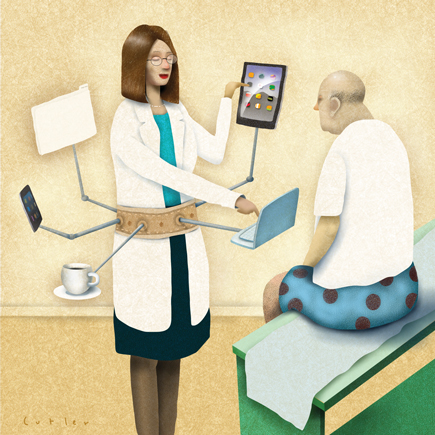Mobile devices offer advantages, challenges
Internists are piecing together technology to improve their practice management, but too many pieces are more of a puzzle than a picture. All the new devices ultimately need to lead to better care, the experts urge.
How many mobile devices does it take to run an efficient, wired primary care office?
Anne Cummings, MD, FACP, wishes it would be fewer than what she's pieced together: one device for dictation, one iPhone to look up drug information and to text her colleagues, another smartphone with a different carrier to work around spotty reception, and a laptop she carries with her to each of her two exam rooms, both of which have a desktop computer.

Amid all the technology, she often ends up sitting next to the patient with the laptop and, yes, the paper chart, on the exam table.
“Although I don't use an iPad, I would prefer its ease of use over the Windows- based platform used by my EHR,” she said.
It's not exactly an ideal setup. As a tech-savvy physician—Dr. Cummings once taught computer programming—she is trying to patch together what works now while the technology plays catch-up to practitioners' real-world needs.
Physicians as a group are very likely to want mobile devices: 81% of U.S. physicians own a smartphone, and 30% of physicians were using an iPad in its first year of release with 28% planning to purchase one in the next six months, according to Manhattan Research's 2011 study of physician digital trends. For now, most physicians are using the devices to read news articles or do searches, but they're interested in point-of-care patient education and access to electronic health records (EHRs).
As physicians work on making the most of whatever becomes available to them, experts urge caution, not only because of potential privacy breaches but also to put the technology in proper perspective.
“Different technologies are hyped by different people,” said William R. Hersh, MD, FACP, professor and chair of the department of medical informatics and clinical epidemiology at Oregon Health & Science University in Portland. “Everything needs to be driven, not just for using technology for the sake of technology, but using it because hopefully it leads to better care.”
What's hot
Given the incentives associated with EHRs and meaningful use, many practices may already be connected with a vendor. However, that vendor may not have a presence on tablets or other mobile technology. Mobile devices offer other possibilities, though, experts said.
Smartphones work well for reading e-mail or looking up facts quickly but are limited by screen size and data entry. As a result, tablets, particularly the iPad and its growing store of apps, are triggering much excitement, especially for hospitalists, residents, and other physicians for whom mobility is essential.
In a 2011 study, Epocrates Market Research found that 22% of physicians are already using a tablet computer and 46% plan to buy one in the next year. Of those who own a tablet, 82% have an iPad.
The devices appeal to physicians of all ages, perhaps because people increasingly use mobile technology in their personal lives, suggested Yul D. Ejnes, MD, FACP, clinical associate professor of medicine at the Warren Alpert Medical School at Brown University in Providence, R.I.
Still, younger physicians may have the edge when it comes to collaborating with other physicians via chat or instant messaging during the course of a patient visit, said Marc Overhage, MD, PhD, director of medical informatics and a research scientist at the Regenstrief Institute Inc. in Indianapolis.
“Younger physicians are more used to this type of disruption. They don't think of it as a disruption,” he said.
Concerned that residents were spending more time at the computer screens and not with patients, the University of Chicago department of Internal Medicine began giving each of its 115 internal medicine residents an iPad and accessories in 2010. In a research letter published in the Archives of Internal Medicine on March 12, Christopher Chapman, MD, ACP Associate Member, chief resident at University of Chicago reported finding 78% of residents said they are more efficient on the ward with the iPad; 70% say it saves them at least one hour per day; and roughly half say it allows them to attend more conferences.
Dr. Ejnes, who is also the chair of ACP's Board of Regents, said he sees the advantages of using a tablet to look up something quickly, such as medical calculations. But he's still figuring out the best ways to use the iPad he got last November for patient care.
Molly Cooke, MD, FACP, the College's 2012-2013 president-elect, said it's less important which device physicians use in clinical practice than that they use it in a patient-centric way. She often uses her iPad in conjunction with her desktop computer during a patient visit.
“It's not easy to move back and forth in various windows once the EHR is running so I'll switch to the iPad to show pictures to a patient or look something up so I can leave the EHR on the monitor,” said Dr. Cooke, William G. Irwin endowed chair, director of the Academy of Medical Educators, and professor of medicine at the University of California, San Francisco. Instead of drawing the inner ear or the heart the way she used to, for example, she bookmarks illustrations she likes and pulls them up as needed.
Dr. Cooke also uses her iPad to offer a second opinion, something she said can alter the typical physician-patient dynamic. She gave the example of a patient with four days of lower back pain who wants an MRI.
“I'll say, ‘Let's look that up and see what the experts have to say about it,’ even though I know. But then I'll look up an ACP guideline and we'll look at it together,” she said.
Because of these advantages, a tablet can lead to shorter visits and happier patients who leave with a better understanding of their medical condition, according to Vesselin Dimov, MD, ACP Member, assistant professor of pediatrics and medicine at the University of Chicago. He has used an iPad for more than a year as part of a patient education effort that includes giving patients printouts along with a link to his website, where they can find videos and action plans.
But the iPad isn't perfect. Some find its onscreen keyboard hard to use and the idea of using a separate keyboard self-defeating. And the issue of compatibility can be a deal-breaker: Dr. Cummings, for example, finds an iPad impractical and doesn't use one because her EHR system can't run on that platform.
Patients react
Initial reaction from patients at hospitals where residents are using tablets is overwhelmingly positive. In a study of 20 patients at the University of Chicago Medical Center, patients approved the use of the iPad for patient education 95% to 100% of the time.
“It was hard to believe,” said Dr. Dimov, who conducted the study. “When we introduced the new tool during the clinic visit we thought maybe the patients would find it distracting, that they might feel the doctor was focused on the computer and would lose eye contact. But our experience wasn't like that.”
It can also work in the outpatient setting, experts said, as physicians get used to using the technology and begin to view it as an aid rather than an unwelcome burden.
“Leverage the computer in the exam room,” rather than consider it a barrier, advised Neil Mehta, MD, FACP, associate professor of medicine and director of education technology in the Cleveland Clinic Lerner College of Medicine. For example, he suggested physicians take a short note in the exam room and fill it out later, allowing more time to show patients trends and images.
For more insight, consider how hospitalists—particularly motivated given their mobility needs—are using tablets.
Henry J. Feldman, MD, ACP Member, a member of Harvard Medical Faculty Physicians at Beth Israel Deaconess Medical Center in Boston and chief information architect in the division of clinical informatics, was among the first to use an iPad at his hospital. He's now one of 1,000 doctors (not including residents and interns) there who bring their own tablets to work.
Dr. Feldman said his iPad enhances patient care. While he's listening to a resident present a case, he's also scanning through the patient's medical history, labs and notes. Since data in the electronic medical record go back to the ‘80s, he can refer to, say, a similar event that the patient had in the ‘90s.
“I look smart, the team looks smart, and the patient thinks we spent longer than we did to understand them,” he said. “But the good news is, we do understand them better.”
Privacy and more
When U.S. Sen. Mark Kirk of Illinois first felt symptoms of what turned out to be a stroke in January of this year, the first thing he reportedly did was text his internist, who immediately directed him to the emergency department.
“That makes me nervous,” said Dr. Cooke, who often travels. “People expect instantaneous responses. ... If you're having a symptom that makes you wonder if you should go to the ER, go to the ER and message me from there. Don't message me instead.” She's addressed her concern by advising patients to think of e-mail and the EHR portal as appropriate for conversations in which there may be a turnaround time of several hours or a day.
Using technology to communicate with patients raises other concerns:
Privacy. It's important to ensure that privacy issues are addressed (e.g., locking the screen, being careful when using voice recognition), experts said, especially if physicians are bringing their own devices to work. Other questions to consider include: What happens if the device is lost? Who controls what happens to that device? How do you coordinate control if one person is on a BlackBerry, one is on an Android, and another is on an iPad?
Professional boundaries. The sixth edition of ACP's Ethics Manual recommends that “Physicians who use online media, such as social networks, blogs, and video sites, should be aware of the potential to blur social and professional boundaries” and notes that they “must be careful to extend standards for maintaining professional relationships and confidentiality from the clinic to the online setting.” It also advises physicians to be aware of privacy settings for secure messaging. ACP's Ethics, Professionalism, and Human Rights Committee is also developing a separate policy on physicians and social media.
Infection control. Dr. Feldman advises physicians to treat their mobile devices as they would anything else they clean between patients. He washes his iPad with wipes available on the ward for sterilizing equipment. He noted that the technique is not manufacturer-approved, but he's done so for two years with no problems. The iPads given to residents at the University of Chicago are covered with a hard case and screen protector to avoid damage from industrial cleaners that the institution approved to clean them.
Reliability. Online information, especially in the relatively unregulated world of apps for mobile devices, can be unreliable (see sidebar on page 15).
Payment. New models of reimbursement are needed to reflect that physicians using mobile technology will spend more time on care that is not delivered face to face, Dr. Hersh said.
Some physicians also worry whether constant online access can go too far. Dr. Ejnes is concerned that technology removes the barriers between work and personal life by having charts, lab results, and more available anywhere.
“Even if patients are sending secure messages at all hours, seven days a week, you have to discipline yourself to make sure it doesn't take over all your free time,” he said.
That's going to be difficult as everyone increasingly becomes exposed to patient care-related tasks 24/7. But mobile devices aren't causing the challenge; they're just one way to deal with it, according to Dr. Cooke.
“You can always be more responsive or learn more about a clinical problem. At some level, this has always been a challenge in medicine,” she said. “It's just a challenge that looked different 20 years ago.”





